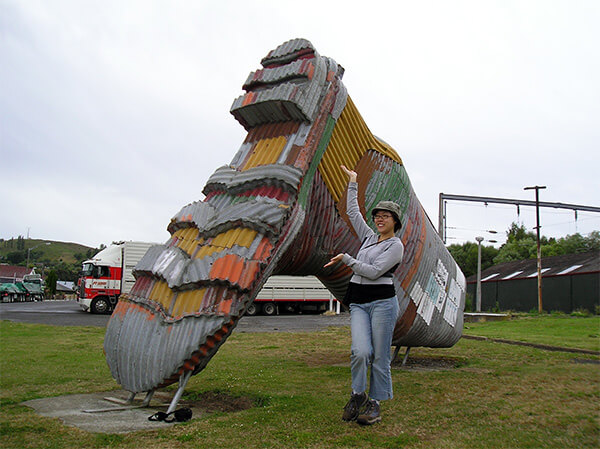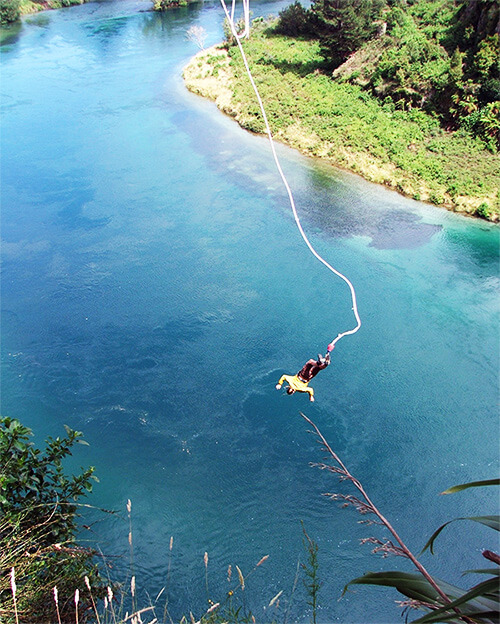Jumping into Volunteering in New Zealand As a Student
Combining Short-Term Volunteer Vacations or Work Exchanges with Travel
Article and photos by Alison Goin

|
|
Jumping off a waterfall in New Zealand.
|
Legs trembling and insides churning, I stand with my mud-splattered Keens peeking out from a scaffold 154 feet above the water. Gazing at the horizon, over which I seem to float, pine and cabbage trees cover the hillsides. Looking down below my shaking feet, rich emerald-blue water shimmers far into the distance . . . and also plummets 525 feet. Welcome to Lake Taupo, a natural jewel of New Zealand’s North Island, where I abandon all senses and leap into possible doom. In 15 seconds, I will be dangling by a bungee cord like a fish caught on a hook suspended above the water.
I found myself at Lake Taupo after I decided to travel to New Zealand and volunteer with a local tourist guide. It was a convenient month-long side trip before I embarked on a study abroad program in Australia. It was also the best adventure I have ever experienced. Back home, I never imagined I would be teetering on the edge of a plank about to bungee jump into a lake. However, my experience as a short-term volunteer in New Zealand significantly shaped my perspectives. It taught me a lot about traveling abroad.
Preparation for New Zealand
Since I had about two months between the end of my university semester and the beginning of my semester in Australia, it was the perfect time to squeeze in some extra traveling. I also liked that switching hemispheres in January would bring New Zealand sunshine and beautiful landscapes in the middle of cold, wet U.S. winter. But I did not want to move about from city to city. I wanted to learn about New Zealand’s culture firsthand.
Looking on the Web for Volunteer Placements
As any globetrotter knows, searching the web for “international volunteering” brings up a host of different sites, and browsing through them can become quite tedious. Prices for different volunteer placements range from nothing to the cost of a small car. The level of program support and in-country assistance also varies. IVHQ and GoEco are very large international organizations that do the legwork for you when you travel to New Zealand. I was bound by a minimal budget, which narrowed my choices and meant I could only afford to trade volunteer work for room and board. I found Ren, a local New Zealand tourist guide who needed extra help, at Help Exchange.
Help Exchange functions like a giant classified ad online; it only lists hosts who want international volunteers at farms, ranches, homes, lodges, B&Bs, hostels, and sometimes sailboats. New Zealand's branch of WWOOF offers similar exchanges. For last-minute excursions, I often saw local ads for volunteer work on hostel bulletin boards.
When I agreed to spend a month with Ren, I had to do some research to ensure working for my host, who is a tour guide, was the kind of experience I wanted. I decided to work for Ren because he had many volunteers before me, and I could tour many parts of the country with him. But you should always ask about your expected accommodations and food, the hours you are expected to work, the type of work, and the nature of transportation in your volunteer areas of interest. Ask the host for past volunteer references to understand what you are getting into.
Experiencing Authentic New Zealand
I touched down at Wellington Airport after 18 grueling hours of flights and layovers. I was anxious to see what lay ahead. Yet, my worries eased when I saw Ren — short and graying, fitted with “tramping” boots — beaming amicably.
When I set foot outside the airport, I realized I needed to learn quite a few lessons. First, avoid lugging a giant red suitcase with you while traveling. They call it backpacking for a reason. Suitcases are heavy and hard to maneuver. If you are in New Zealand, pack for any climate. You might be wearing a raincoat in the morning but sporting a swimsuit on the beach in the afternoon.
Just because you enter a country where people speak English, the culture and certain words will still be foreign to you. At first, I had trouble understanding the different words and pronunciations that Kiwis used. For example, a bathroom is called the “loo.”
Other cultural adaptations were required as well. I tried not to wince whenever another car slipped by us on the “wrong” side of the road. I had no idea what the rainbow banknotes and silver coins in my pocket were worth. I did not know so many sheep could cover such a small country. And when we went to cafes, I was astonished that people poured milk into their tea and ate pies filled with meat.
Once I arrived at Ren’s house, I settled into a room and got to work. I weeded the garden, painted the porch, and helped Ren with any needed project. Nothing was too strenuous, and I continued to learn about New Zealand life through Ren’s stories while I worked.
As an international volunteer, you also meet other volunteers who enjoy sharing their ideas and culture. I volunteered with a German girl who worked for a time picking kiwi fruit, and then she spent a week backpacking in one of the many national parks. I learned some excellent traveling tips from her. For example, if you are going to go “tramping” for a long time in a forest, you can give a notice to the New Zealand Park Service so they will search for you if you do not return on time. I also worked with a Canadian and met Australians, Lithuanians, and English citizens. It is good to meet other foreigners with whom you can commiserate about the tribulations and triumphs of traveling. They can also become good travel partners later if you are heading in the same direction.
What to See in New Zealand
I was lucky to have a tour guide as a volunteer host. Taking care of some essential duties, I rode on tours to gorgeous sites. However, traveling the country is very easy without a tour guide. There are tourist info centers in nearly every town with maps, car rentals, buses available, hostel locations, and suggestions regarding what to see. Excursion Prices are decent, especially considering the exchange rate from U.S. dollars to N.Z. dollars. Most multi-room hostels usually cost 20-35 U.S. dollars per night.
One of my favorite cities in New Zealand was Wellington, the national capital. This vibrant harbor city holds some of the finest cultural events. I was amazed by the Te Papa museum, which examines the country’s history, including the roots of the native Maori people. The city also has the vintage Cable Car Museum, where you can ride the “relentless red rattler” up a hill and stroll around the lush Botanical Gardens below. Auckland and Christchurch are also excellent cities to visit.
If you want a more intimate setting, go to small towns, which are the places where you will most likely volunteer anyway. There, you will find true Kiwis with great national pride and a sense of humor. Many towns have a giant statue that seems to stake out the townspeople’s spot on the earth. They seem honored to live in the big carrot, giant shoe, or giant cow town. Before I saw it, Ren tricked me into thinking the 15-foot-tall cow was real.

|
|
New Zealand has its own sense of humor.
|
Suppose you are like me and have a passion for visiting natural wonders. In that case, nearly every corner of the country has something to see. I recommend tramping around Mt. Ruapehu and the Tongariro Crossing, where scenes from the Lord of the Rings were filmed. In Rotorua, geothermal geysers and bubbling hot mud pools will make you feel like you are on another planet. Indeed, it would be best to take advantage of the Cook Strait Ferry, which carries you from the North Island across the scenic blue Pacific Ocean to the South Island.
Finally, depending on your level of bravery, New Zealand also boasts some of the best places to do extreme sports. You can zip line down a river canyon face first at the Mokai Gravity Canyon, attempt skydiving in Queenstown, or go whitewater rafting on the Rangitaiki River. You can even take on the daring bungee jump in Taupo like I did.

|
|
Bungee jumping while in New Zealand.
|
Remembering the Adventure
I jumped. Not because I am an adrenaline junkie or a heedless traveler but because I wanted to prove to myself that I could do it. I could bungee jump. I could travel halfway across the world and see incredible things I never knew existed. I could make new friends and a new family who would show me a lighter side of life and the importance of being proud of who you are. My international experience even prompted me to enter a major and career path to study language and communication. If I had not taken the opportunity to volunteer in New Zealand, I would not have been the same. Technically, I am an American, but now I have become a citizen of the world.
|
For More Info on New Zealand
Volunteering is a great way to experience New Zealand's natural beauty and unique culture. The first step is to find a program or host that will meet your needs and deliver your desired experience. It is wise to look at the details of each opportunity before heading out on your adventure.
The following are a few of the many websites available for volunteer experiences in New Zealand:
Help Exchange (Work exchange and volunteer)
WWOOF New Zealand (Work exchange on organic farms)
Editor's note: See TransitionsAbroad's New Zealand directory for volunteering for more options.
If you are flying into New Zealand from an international location, you will probably start your journey at Auckland Airport (WLG), Wellington Airport (AKL), or Christchurch Airport (CHC). For airport shuttle and in-country bus travel from one of these airports, visit www.newzealand.com/us/airport-shuttles/ to check out your options.
|
Alison Goin is a post-baccalaureate student at the University of Oregon, where she is in her fifth year. She has a bachelor's degree in Journalism and is working to get a master's in Communication Sciences and Disorders.
Alison's essay details her experience traveling through and volunteering in New Zealand. She then went to Australia to study abroad.
|
